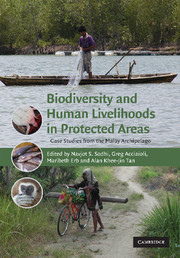Book contents
- Frontmatter
- Contents
- List of contributors
- Acknowledgements
- 1 General introduction
- Part I Conservation needs and priorities
- 2 Introduction to Part I
- 3 Delineating Key Biodiversity Areas as targets for protecting areas
- 4 A Master Plan for Wildlife in Sarawak: preparation, implementation and implications for conservation
- 5 Indonesia's protected areas need more protection: suggestions from island examples
- 6 Birds, local people and protected areas in Sulawesi, Indonesia
- 7 Importance of protected areas for butterfly conservation in a tropical urban landscape
- 8 Biodiversity conservation and indigenous peoples in Indonesia: the Krui people in southern Sumatra as a case study
- 9 Involving resource users in the regulation of access to resources for the protection of ecosystem services provided by protected areas in Indonesia
- 10 Conclusion to Part I
- Part II Conservation with and against people(s)
- Part III Legal and governance frameworks for conservation
- 29 General conclusion
- Index
- References
2 - Introduction to Part I
from Part I - Conservation needs and priorities
Published online by Cambridge University Press: 12 November 2009
- Frontmatter
- Contents
- List of contributors
- Acknowledgements
- 1 General introduction
- Part I Conservation needs and priorities
- 2 Introduction to Part I
- 3 Delineating Key Biodiversity Areas as targets for protecting areas
- 4 A Master Plan for Wildlife in Sarawak: preparation, implementation and implications for conservation
- 5 Indonesia's protected areas need more protection: suggestions from island examples
- 6 Birds, local people and protected areas in Sulawesi, Indonesia
- 7 Importance of protected areas for butterfly conservation in a tropical urban landscape
- 8 Biodiversity conservation and indigenous peoples in Indonesia: the Krui people in southern Sumatra as a case study
- 9 Involving resource users in the regulation of access to resources for the protection of ecosystem services provided by protected areas in Indonesia
- 10 Conclusion to Part I
- Part II Conservation with and against people(s)
- Part III Legal and governance frameworks for conservation
- 29 General conclusion
- Index
- References
Summary
Although 12% of the planet's surface is protected, the global protected area network fails to encompass about a quarter of threatened vertebrate species that are in dire need of protection (Rodrigues et al. 2004). This result suggests that there may be a need to designate more protected areas, especially in the tropics where two-thirds of global biodiversity resides. Protected areas (reserves or national and regional parks) may be the only hope for retaining a reasonable proportion of residual tropical biodiversity (Bruner et al. 2001). However, major ongoing land conversion in the tropics will exert a massive negative impact on its biodiversity by the year 2100 (Sala et al. 2000). This anthropogenic land conversion is not limited to areas under no legal protection, as shown by DeFries et al. (2005). Using satellite imagery, they determined the habitat loss between the early 1980s and 2001 in 198 protected areas across the tropics that are critical for biodiversity (due to large size, a high level of protection and the presence of intact forests within the administrative boundary). Forest loss within and outside ‘buffer’ areas (the surrounding 50 km) was determined. Of the protected areas surveyed, 25% lost forests within their administrative boundaries, with 70% of them losing forests even in buffer areas. Buffer areas are critical as they dampen the negative effect of invasive species, fire and hunting in the protected areas.
Information
- Type
- Chapter
- Information
- Biodiversity and Human Livelihoods in Protected AreasCase Studies from the Malay Archipelago, pp. 9 - 19Publisher: Cambridge University PressPrint publication year: 2007
